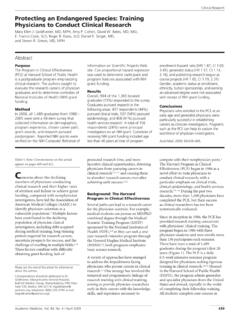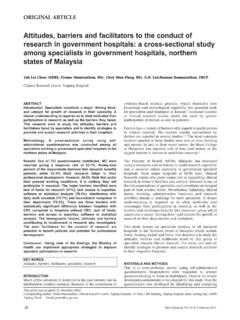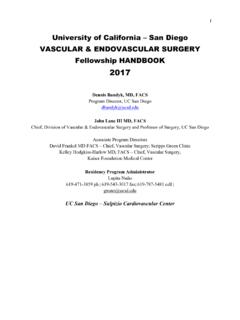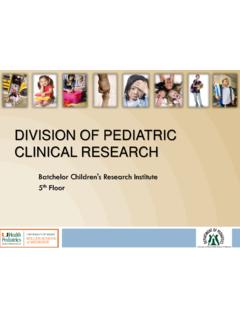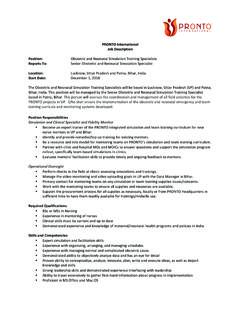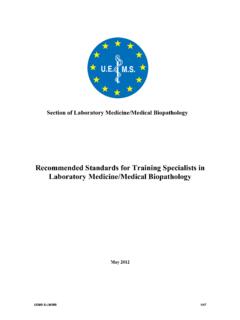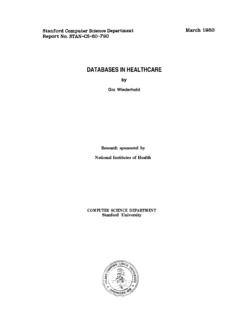Transcription of Clinical Documentation Improvement Job Description ...
1 Clinical Documentation Improvement Job DescriptionSUMMATIVE REPORT 20141 |CDI JOB Description SUMMATIVE 2014 IntroductionClinical Documentation Improvement (CDI) has been an ongoing process for monitoring accuracy and efficiency of patient care for decades. 1 The imple-mentation of governmental requirements and expansion of information technology in health care has brought the profession to the forefront in quality management practices. According to Butler (2014 ), Federal initiatives such as the meaningful use EHR Incentive Programs and its numerous quality measures, Medicare and private insurance audits, value-based purchasing, accountable care organizations (ACOs), advancements in health IT, enhanced patient engagement initiatives, and the transi-tion to ICD-10 demand a high volume of clean, granular, accurate, and coded data.
2 1 These initiatives have changed the landscape of the healthcare industry and advanced the role of the Clinical Documentation Improvement specialist (CDIS). Building upon the AHIMA Code of Ethics, 2 the AHIMA Ethical Standards for CDI Professionals and the Association of Clinical Documentation Improvement specialists (ACDIS) Code of Ethics 3 identify principles intended to assist in decision making processes and actions, outline expectations for making ethical decisions in the workplace, and demonstrate the professionals commitment to integrity. 4 These standards further enable professionals to define the roles and responsibil-ities of the CDIS. According to Brian Murphy, Director of ACDIS, CDI specialists serve as the bridge between health information management and Clinical staff, 5 providing a vital link for accuracy of Documentation and quality patient care (CDI Week, 2013).
3 Recognition of the emerging roles and diversity of the profession is import-ant to the future growth of the field. The purpose of this study is to examine criteria for the CDIS position as listed within CDIS job descriptions. An assessment of CDIS job descriptions provides a descriptive picture of the pro-fession as well as the knowledge and skill sets employers anticipate will be part of the professional s expertise. MethodologyIdentification of variables associated with CDI job descriptions was conducted with AHIMA Foundation staff prior to data collection. Members of the AHIMA Foundation team reviewed self-selected job descriptions for Clinical Documentation Improvement specialists and identified specific variables of interest.
4 Following discussion, thirty-one (31) variables were identified. A data dictionary was developed by the AHIMA Foundation RHIA creden-tialed consultant (see Data Dictionary in Appendix A). Numeric codes were assigned for variables to be entered into an Excel spreadsheet. Based upon reported workforce figures, 337 job descriptions were randomly selected from Internet job search engines ( HCPro, CareerBuilder, SimplyHired, Glassdoor, etc.). Collection of data was randomized by identification and subsequent collection of every other CDI job Description . Job descriptions for remote positions were not collected as directed by the AHIMA Foundation leadership. A Confidence Level of 95% and Confidence Interval of 5% was established.
5 An Interrater Reliability of 86% was achieved by two reviewers through an evaluation of 5% of the 337 job descriptions (N=16).ResultsA total of 337 job descriptions were randomly selected and reviewed resulting in over 10,000 variables (337X 31=10,4 47). A detailed listing of results shown through Excel data charts can be found in Appendix B. Results are presented by Title: Clinical Documentation Improvement (CDI) Job Description Summative ReportSubmitted By: Susan Hart-Hester, , RHIAA cknowledgement: The report was supported by a philanthropic contribution from Career Step LLC2 |CDI JOB Description SUMMATIVE : A number of titles were associated with CDI: 1) Associate, 2) Specialist, 3) Manager, 4) Other, and 5) Director/Supervisor.
6 Data show that 80% (269) of the descriptions specified job titles as CDI Specialist. Eight percent (8%, 28) were CDI Managers with 7% (24) CDI Director/Supervisors. Four percent (4%, 13) identified the CDI along with another job category such as Case Management or Coder. Less than 1% (3) named a CDI Associate in the job Description title. Figure 1 depicts CDI job titles as listed in the descriptions 1. CDI Job Titles80%1%4%7%8%CDI Job Descriptions By TitleCDI Associate CDI Specialist CDI Manager Other CDI Director/SupervisorDepartment: This variable specifies the department overseeing the CDI work. This category resulted in six identified areas: 1) HIM, 2) Nursing, 3) Other, 4) Not Specified, 5) Revenue/Finance, and 6) Quality Management.
7 Percentages were calculated on subtotals per area following the subtraction of the number of data points designated as not specified or missing variables. This resulted in a denominator of 290 (337 47). Data indicate the majority (79%) of CDI work is conducted in the HIM department (228) with Revenue/Finance and Quality Management at 5% (15, 14 respectively). The Nursing department was indicated in 4% (13) of the descriptions reviewed. An additional 20 descriptions (7%) showed other department categories such as Care Coordination. Figure 2 depicts the departments overseeing the CDI work by 2. Departments2281320151447 HIMN ursingOtherRevenue/FinanceQuality ManagementMissing 2014 CDI JOB Description SUMMATIVE REPORT 20143 | Report: This variable assessed whether the CDI had direct report to a designated position or title within the department.
8 Data show 46 job descriptions (14%) specifying direct reporting for the CDI position. Eighty-six percent (86%, 291) of the job descriptions did not specify whether the position had direct reporting responsibilities or a designated position or title for direct report within the department. Figure 3 shows these percentages in a pie 3. Direct Report86%14%Yes NoDo CDIs Direct Report?Years of Experience Required and Years of Experience Preferred: Job descriptions were reviewed for the number of years experience required as well as the number of years experience preferred. The number of years required averaged years while the average number of years preferred was years.
9 Data for both variables ranged from 1 to 10 years. Figure 4 provides a graphic comparison of the average number of years required alongside the average number of years 4. Average Years Experience Required and PreferredEducation Required: This variable was categorized into five areas: 1) Associate, 2) Baccalaureate, 3) Graduate, 4) Not Specified, and 5) High School. Percentages were calculated on subtotals per area following the subtraction of the number of data points designated as not specified or missing variables. This resulted in a denominator of 304 (337 33). Fifty-three percent (53%, 160) of the job descriptions indicated that a baccalaureate degree was required for the position while 44% (134) required at least an Associate degree.
10 Only 3% (9) required a minimum of a high school diploma while less than 1% (1) required a graduate degree. Education Preferred: This variable was categorized into four areas: 1) Associate, 2) Baccalaureate, 3) Graduate, and 4) Not Specified. Percentages were calculated on subtotals per area following the subtraction of the number of data points designated as not specified or missing variables. This resulted in a denominator of 136 (337 201). Sixty-nine percent (69%, 94) of the job descriptions indicated that a baccalaureate degree was preferred for the position while 23% (32) preferred a graduate degree. Ten descriptions (7%) indicated a preference for an Associate degree.




